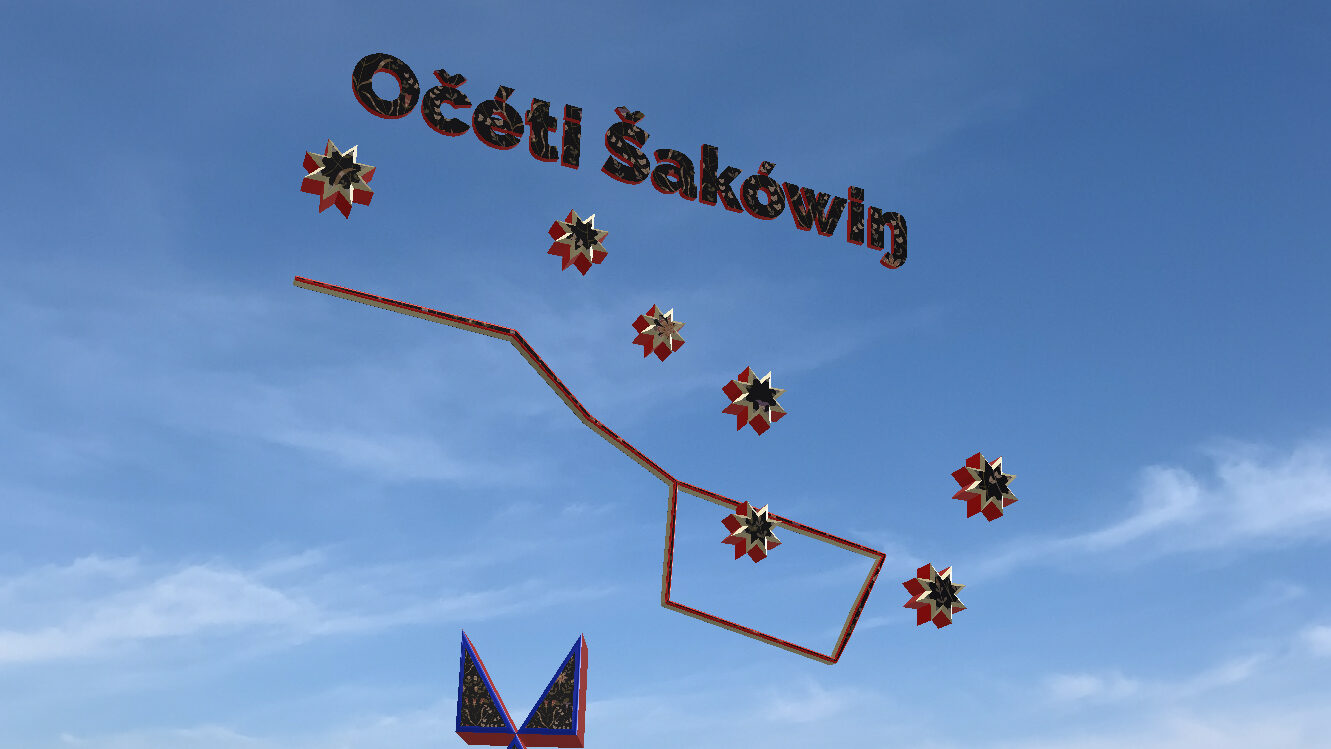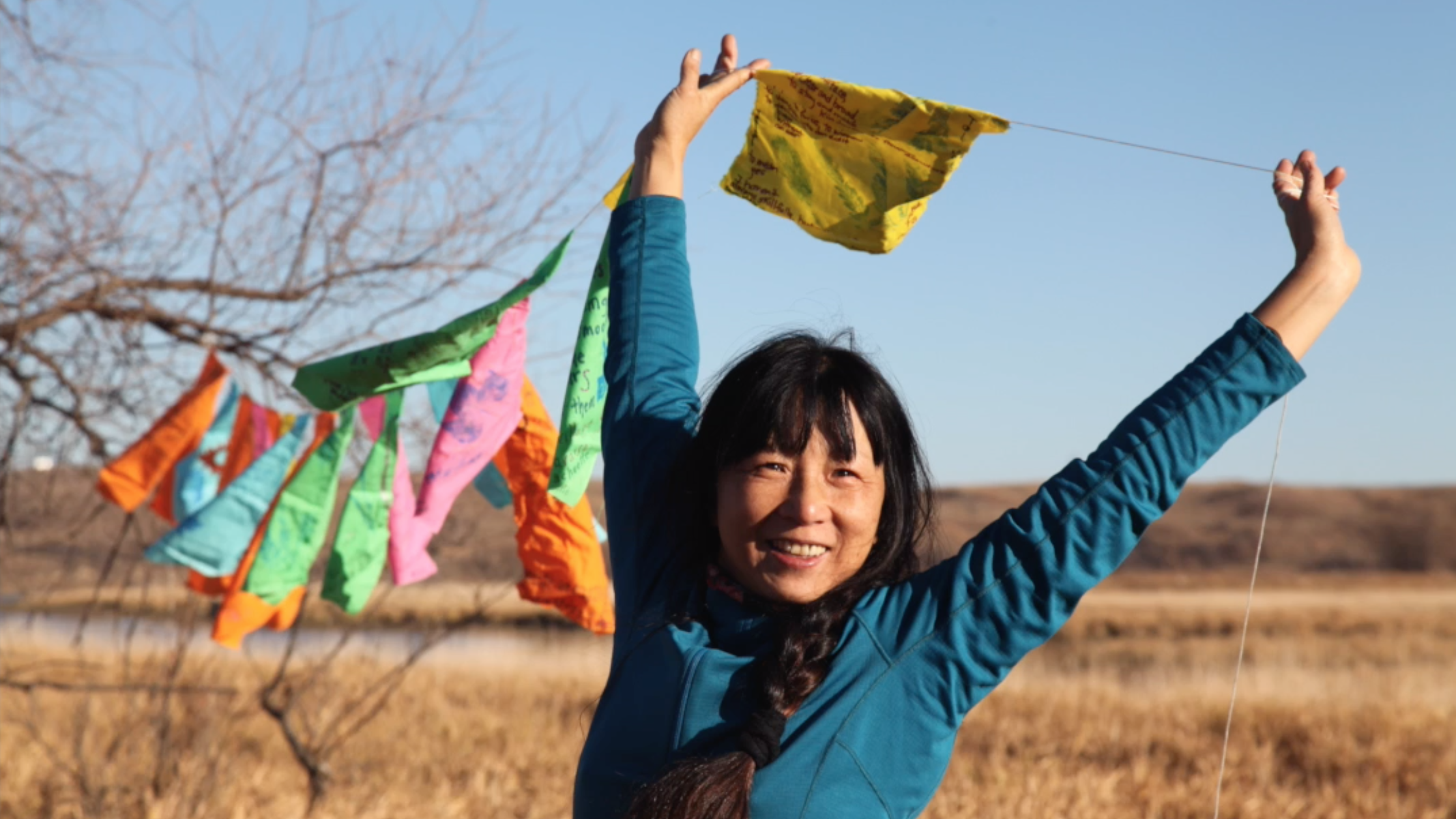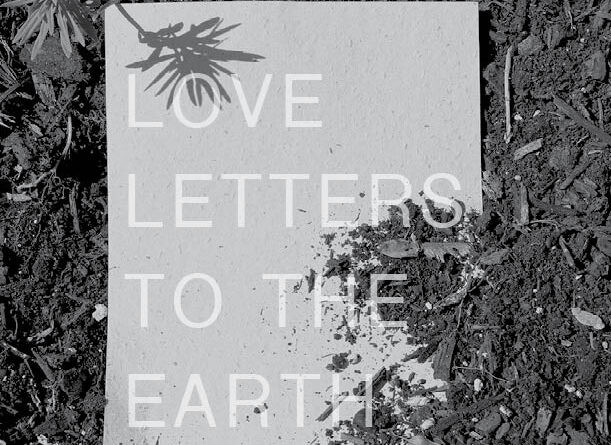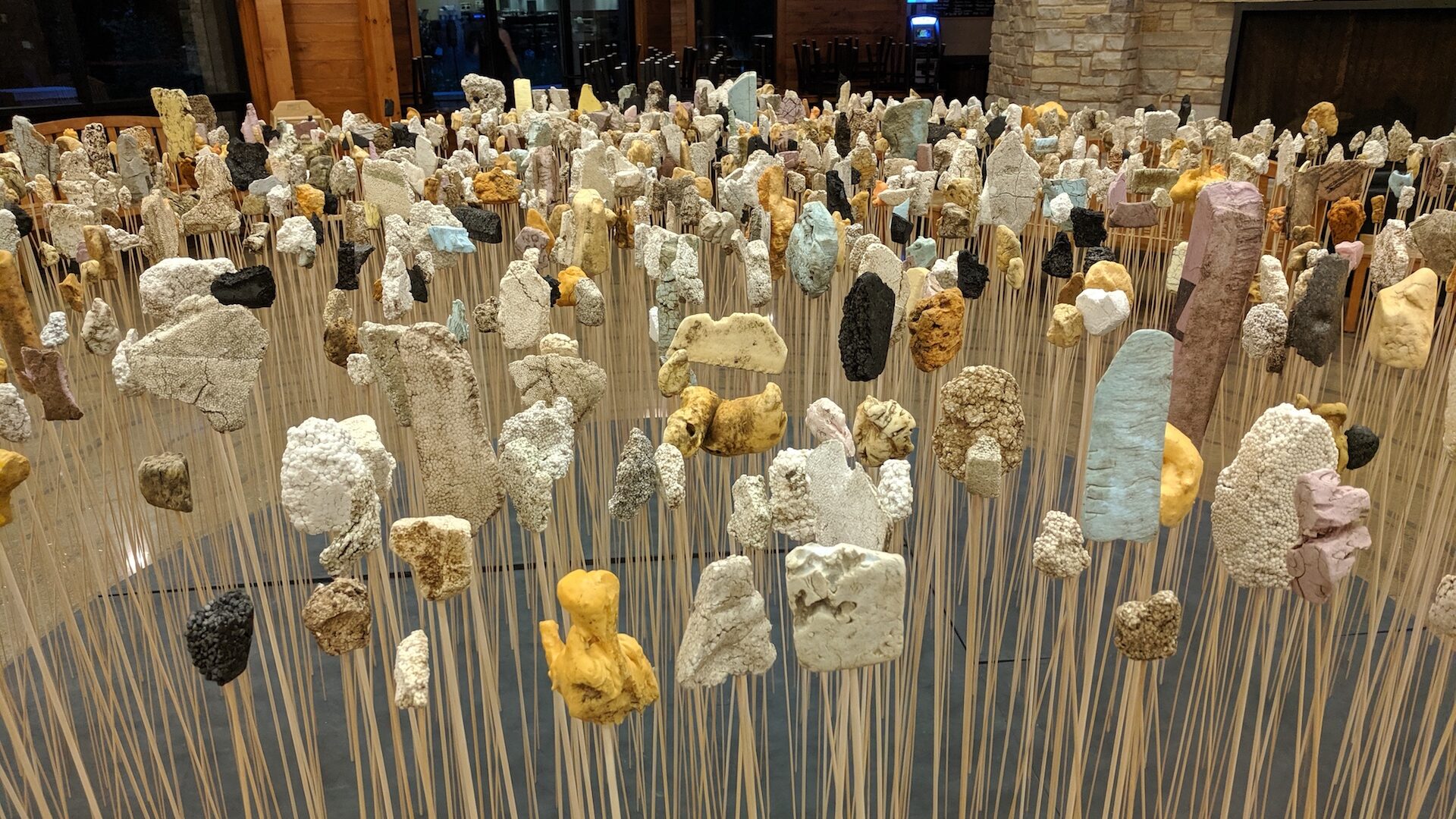Throughout sites across the Midwest, the 4Ground Midwest Land Art Biennial projects offer a refreshed look at the concept of land art, according to Franconia Sculpture Park’s Executive Director Ginger Shulick Porcella.
“It’s not just a big pile of dirt or rock,” she says. “There are a lot of other ways that we can celebrate the land, like through augmented reality, through performances, through prayer flags. A lot of these installations take place along waterways and just getting people to think about the relationship to not only the land, but the water, and also raise awareness of the Dakota people, the land, the history of the land, and land art that may not be here anymore.”
Shulick Porcella says the project offered a way for Franconia to use its resources and platform to create a template for other organizations to collectively curate and fundraise and market on a larger scale. “It’s a Franconia program, but it’s really about all of us working together and not being siloed,” she says. “It was really co-developed through these different community partners. This is what came out of these discussions— this idea for a festival that really celebrates the beauty of the upper Midwest and the history, and the art.”
Susan Haugh, program director for the Belwin Conservancy, an organization based in the Saint Croix Valley, says the process of putting 4Ground together has been a time of connection with other organizations that share similar missions across four states. “It’s really enriched us in knowing who’s out there and connecting us, and feeling like we all can pick up the phone and call one another and support one another on this project,” Haugh says.
For Belwin, an organization that has an aim to restore land to healthy ecosystems and bring people into the great outdoors, the notion of using art to engage people with nature was a “no-brainer,” Haugh says. “Belwin is all in. We want to bring more people out to this incredible place, to experience restored prairie and to understand the importance of healthy soil. It’s exactly our mission to connect people to wild spaces.”
Here’s a sampling of just a few of the projects that are a part of 4Ground:
Throat-singing with Taiquaa//Ambe Omaa – ayaga//babaami-ayaa (to travel around)

Indigenous artists/musicians Anastasia Adams and nibiiwakamigkwe met by chance a few years ago when they both happened to be working for the same nonprofit organization. It was there they learned they had a shared interest in throat singing. Adams is Central Yup’ik, and was adopted out of her culture. As an adult, Adams has reconnected with her heritage through music. Nibiiwakamigkwe, meanwhile, is Oneida, a descendent of the Leech Lake Band of Minnesota Ojibwe, and registered with the Manitoba Métis Federation. Those tribes don’t have throat singing as part of their heritage, but nibiiwakamigkwe began learning the skill about 10 years ago, when they attended their cousin’s wedding and throat singing was a part of the festivities.
“It’s a tradition that’s been practiced for so long, oftentimes between two women/children,” nibiiwakamigkwe says. “It’s done while people were away hunting and when you’re hungry and you’re cold and needed a way to pass the time.”
Nibiiwakamigkwe says they were taught to always be the follower in the vocal form, in order to be respectful of the culture. When they sing, Adams takes the lead, while nibiiwakamigkwe follows very close behind in a beautiful pattern. Adams, whose background is in vocal performance and music, composes the songs, which they both perform.
Besides throat singing, the duo, called Taiquaa//Ambe Omaa (which translates to “come here” in different indigenous languages) also creates visual art, created by nibiiwakamigkwe. For their 4Ground Project, the artists will be leaving a trace at three different sites, by setting up camp. They’ll install large waxed tarps, which nibiiwakamigkwe will then cut up using birch bark patterns.
The three sites are at the Rochester Art Center, the Belwin Conservancy, and Plains Art Museum. “We will actually be moving in a northwest direction, which is ironic in a lot of ways, and a little bit of an anti-Manifest Destiny acknowledgement on our end,” nibiiwakamigkwe says. “We’re really acknowledging the the histories that have shaped this land.”
In the case of the Rochester Art Center, for example, they point to the area’s removal of Dakota and other tribes out of Southern Minnesota. “A lot of what we’re actually thinking about is what are the things that you carry and are able to bring with you when you are forced into exile like this,” nibiiwakamigkwe. “The songs that we’re seeing are actually incorporating different seeds that were carried with those ancestors.”
Dakota Spirit Walk with Marlena Myles – Saint Paul, MN

Artist/animator and designer Marlena Myles teamed up with artist/inventor Todd Boss through an app called Rovelo, as well as Pixel Farm Studios, for a permanent site-specific installation called the “Dakota Spirit Walk.” The project uses geolocation, audio, and 3D animation to create a virtual experience that takes place at the Bruce Vento Nature Sanctuary and connected Indian Burial Mounds. The site is a sacred space for Dakota people, and has seen damage in past years to the burial mounds because of industry. Since 2005, the city of Saint Paul has worked to restore the grounds.
Myles’s project offers a lens to experience Dakota history and culture through virtual reality. Her multi-layered approach reveals hidden stories, including narratives about Dakota creations, like the mounds. Her keen storytelling and evocative animation gives you a deeper look at Native presence in Saint Paul.
“I think augmented reality is a really great tool for public art and sculpture,” Shulick Porcella says. “You can sort of place it anywhere, but without the footprint of having to disturb the land. It’s accessible for anyone with a phone.”
Kinship of Rivers – Fountain City, WI

Fountain City, Wisconsin is across the Mississippi River from Winona, Minnesota, on the Wisconsin side. It’s in the Driftless Region, which unlike more Northern parts of Minnesota, wasn’t flattened by glaciers. There, you’ll find the Kinstone Megalithic Garden, a sculpture park made to look like the historic Stonehenge in Scotland.
Shulick Porcella says she wanted to include the Kinstone Site because besides being cool, is also quite under the radar. “I wanted to to get people to go places that they wouldn’t normally maybe go to, or they haven’t heard about,” Shulick Porcella says. “And get outside their comfort zone.”
Kinstone is built on the property of founder Kristine Beck, who purchased 30-acres of the land where she grew up, which her family owned for 4 generations.
At the site, you’ll find a continuation of a project poet and artist Wang Ping has been exploring 2011, using Tibetan prayer flags as inspiration. For the Kinstone project, she’s collaborating with artist Joe Lerro where they’ll wrap the stonehenge structures with flags and also plant beans, creating a piece that will continue to evolve as the season progresses.
“All summer, people can go to Kinstone and create these flags that’ll be incorporated into the installation,” says Shulick Porcella. The opening event takes place on the Solstice, which will have drumming by Al Baker.
Love Letters to the Earth – Fargo, ND

Torey Erin’s living art piece, “Love Letters to the Earth,” is presented with the Plains Museum as well as the community garden Growing Together and the placemaking initiative The Fargo Project. It takes place at the World Garden Commons at Rabanus Park. Located between residential and commercial property, the site was developed as a way to transform an 18-acre stormwater retention basin into green space and neighborhood commons. It is filled with native prairie and wetlands, walking paths, an amphitheater, a community garden an other amenities as a way to create a livable, useable space that brings community together.
Erin’s project kicked off on June 2, when students and community members wrote love letters to the earth on seed paper. Erin then planted each letter into a garden installation that will continue to grow throughout the summer. Both a garden and an art project, “Love Letters to the Earth” offers a way to show care to nature and offers seeds of hope for the future of the planet.
98% Air – Rochester, MN

Outside of the Rochester Art Center you’ll find an installation by Presley Martin, called “98% Air.” The sculptural work is made of 9000 pieces of plastic foam from the Mississippi River. From a distance, the installation looks like it could be reeds or some sort of natural phenomenon. The trash is so degraded it has developed the look of the natural world.
As part of the project, Martin is leading workshops that engages with the non-biodegradable materials. Visitors create paint brushes in these workshops used to create art. Through this process there is a hopeful message. Even in the face of degradation we have the tools to do something about the impact humans have on the planet, like bringing awareness to the problems through the use of art.
While you visit the Rochester Art Center, you’ll also want to take a look at the rest of “Walk With Us,” an exhibition curated by John Schuerman and Zoe Cinel. The walking-based exhibition features 15 artists that examine social, physical and physical landscapes accessible by walking. Taking place in the hallways, elevators, alcoves of the art center, the artists offer places of discovery through their work.
To learn more about the different artists and projects involved with the Biennial, visit 4Ground’s website.
